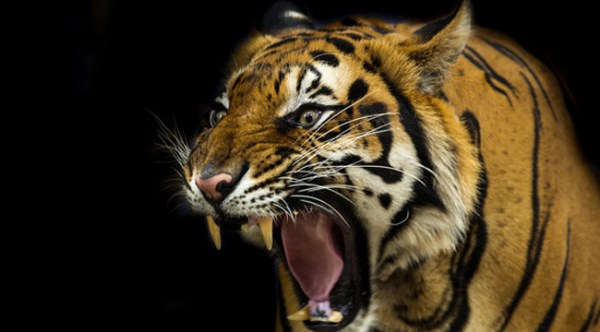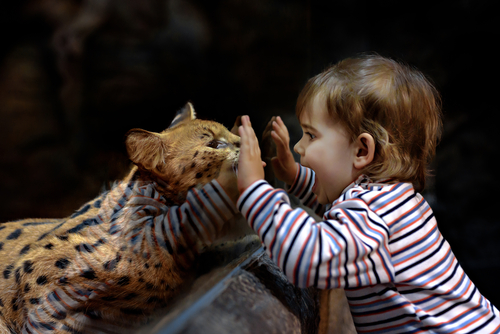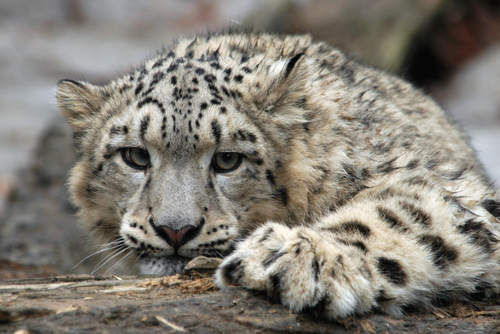
“If the names are lost, the knowledge also disappears.”
-J.C. Fabricius from Philosophia Entomologica
Every day, Association of Zoos and Aquariums (AZA)-accredited zoos open their doors to the public, inviting people to witness the animals in their care. Many of the people visiting will be attending with the goal or hope of being entertained. They’d like to spend a fun day outside of their homes. They’d like to tempt their children away from screens and media. They’d like to see unusual sights — creatures they could never hope to see in their own backyards, even if, once upon a time, their backyards would have been the roaming grounds for those very animals.
It’s possible that some of these visitors will think of the zoo as a place built solely for the purpose of their entertainment. They will go into their visit expecting to be distracted from the world in the same way a movie or a theme park or a bowling alley is meant to distract them. It’s not a terrible thing, to want to be entertained. It’s not a terrible thing to be fascinated by animals, or to hope to see them closer. It’s just that those wants and needs are not the sole reason for the existence of the modern, AZA-accredited zoo, and they haven’t been for some time.
Believing you’re visiting a theme park where animals are on display purely for your entertainment does not make it so. Even if you do come away from the visit entertained. In fact, a three-year, nationwide study found that: “Visitors arrive at zoos and aquariums with specific identity-related motivations, and these motivations directly impact how they conduct their visit and what meaning they derive from the experience.”
In other words, each guest’s preconceived notions about what a zoo is or isn’t impacts the way that visitor values the zoo.

In a time in which human thought processes about zoos are rapidly changing, it’s important to clarify what AZA-accredited zoos have as their mission. The modern zoo exists and continues to evolve as a center for conservation, education, and research. Hundreds of years ago, the zoo’s progenitors may have been a way for the royal and the wealthy to exhibit their dominion over the natural world. Today, zoos have more to do with stewardship of a planet in the midst of a sixth mass extinction — offering man-made aid in the face of a man-made crisis — than they do with exhibiting mastery over non-human animals.
Consider the following:
Catalina Island Fox
Scimitar-Horned Oryx
Przewalski’s Horse
Pere David’s Deer
Perdido Key Beach Mouse
Eastern Barred Bandicoot
Blackfooted Ferret
Ozark Hellbender
Timber Rattlesnake
Ploughshare Tortoise
Kihansi Spray Toad
Oregon Spotted Toad
Mountain Chicken
Mauritius Kestrel
Regent Honeyeater
Puerto Rican Parrot
Blue-crowned Laughing Thrush
Micronesian Kingfisher
Guam Rails
Spix’s Macaws
Attwater Prairie Chicken
Bali Mynah
Partula Snail
Lord Howe Stick Insect
White-clawed Crayfish
American Burying Beetle
Can every reader picture each and every animal listed above? Can you see it in your mind’s eye, bring it to life with your imagination, as easily as you can a Sumatran tiger, an African elephant, or a Western lowland gorilla? Are there any animals in the above list that you didn’t recognize? That you’ve perhaps never heard of? Do you know what each of these diverse species have in common?
All of these species continue to exist largely because zoos have been fighting for their survival. Whether or not you knew they existed. Whether or not you knew that they were in danger of blinking out of existence, a network of people, connected by their professions and passions, were endeavoring to save them. These people used, and continue to use, their collective knowledge, their research, and their determination to save critically endangered species, including those that many of us have never spared a thought for. The list provided barely scrapes the surface — it’s a minuscule sample of the important work of zoos that goes largely unnoticed, the work that zoos have been directing their focus toward for years.
Zoos exhibit animals in order to pull the blinds away from a window on the natural world that has been shuttered by habitat loss, industrialization, pollution, greed, and apathy. They reconnect humans with nature in such a way that visitors are inspired to conserve and protect wild animals and the wild spaces they require in order to survive and thrive; and they lead by example. Here’s how:
Connect, Then Protect
You can’t care about something if you don’t know it exists. Know what a Partula snail is? Or that a Mountain chicken is actually a type of frog? You would if you’d visited Saint Louis Zoo or Detroit Zoo, where both species are part of conservation efforts. We have a harder time turning our back on someone or something once we actually see it in person. Jake Page, author of Smithsonian’s New Zoo, wrote, “It is difficult to be concerned about the fate of an animal you have never seen. Even a two-dimensional film representation of an animal does not have anywhere near the same effect as seeing one in the flesh, hearing it, smelling it.”
Once that connection has been made, zoos utilize education to help zoo guests discover how it is that they can continue to care for that animal, beyond their visit. The aforementioned study found that “most visitors leave the zoo or aquarium thinking differently about their role in environmental problems. A major finding was that individual action messages, such as, “There is a lot I can to do conserve,” and, “I am part of the solution to nature’s problems,” significantly increased as a consequence of the visit (61% and 54% increases, respectively).”
This is important. There’s a video circulating currently of a little boy sobbing because, essentially, he feels like the natural world is doomed and no one cares. It’s endearingly-heartbreaking and sweet and precocious all at once, but it’s also a little devastating. There are tons of adults that already feel that way about so many endangered species. Look at any of the comments in my previous conservation articles; you’ll generally find at least one person who thinks species x or y is past the point of no return, that there’s nothing we can do, and that we might as well let it go. How lucky we are that the people helming the Przewalski’s horse recovery project didn’t feel that way when the population dwindled to roughly fifteen animals.
The message at zoos is never that there’s nothing any of us can do, but there’s something that all of us can do, even if we’re at the brink. It’s empowering.
On a personal level, zoos were the first places that I took in sustainable seafood messaging, and discovered how to become an active participant. I changed my eating habits because of my visit to an aquarium. Zoos were where I first considered how my role as a consumer played into the deforestation of Southeast Asian forests. I saw my first clouded leopards — a species rarely glimpsed in the wild — and began to actively look at what I was buying, and how it might affect these captivating animals, which I’d previously never known about. I take time out of my day to call companies and ask if they utilize deforestation-free palm oil.
Zoos are the reason I buy shade-grown coffee and use a mug instead of a cardboard cup, and it’s because of a zoo’s resident polar bears that I unplug my electric kettle and toaster everyday, even though every morning, I’ll be slightly annoyed that I’m going to have to root around behind the cereal boxes to plug them in again. It feels a lot more personal when I picture polar bears I know. If the last time you visited a zoo was in your childhood, you might consider visiting one again, and taking note of the opportunities availed to you to learn about the species on exhibit: keeper talks, signage, close encounters, and impromptu discussions with volunteers and zookeepers may well impress you more than you ever expected.
Species Survival Plans — Living Arks
Over 50 species exist today thanks to the work of zoo breeding and reintroduction plans. Some of those species were shouted out in the beginning of this article. Some of them you’ve met in my previous article on zoos, which details the ways in which six different species were bred and reintroduced into the wild. The work isn’t done.
Each AZA-accredited zoo works in concert with other facilities, government wildlife agencies, and conservation organizations, to support threatened or endangered species populations. Currently, over 450 Species Survival Plans (SSPs) exist; programs developed to ensure the continued existence of animals, while collectively, the planet struggles to preserve wild habitats, and balance their existence with the needs of an expanding populace.
According to AZA, functions of the Species Survival Plan include:
- Establishing management, research, and conservation priorities.
- Developing a Breeding and Transfer Plan.
- Serving a specific role in conflict resolution issues that may arise.
- Collaborating with other institutions/agencies to ensure integrated conservation initiatives.
- Increasing public awareness of wildlife conservation issues.
- Developing and implementing ex situ and in situ education strategies.
- Developing in situ reintroduction programs, if possible.
Think of an SSP as a living ark — a genetic hedge against extinction. The problem of maintaining safe, viable, and appropriate habitats for many species is an ongoing one. African and Asian elephants continue to be poached, African elephants at the rate of 96 elephants per day. They’re killed on preserves and protected land. Tigers of all remaining subspecies suffer from habitat loss and fragmentation as well as poaching, despite laws that offer them protection. Western lowland gorillas face similar issues.
For these large, iconic species, the future remains uncertain, but it’s a future championed by zoos, and bolstered by the SSPs which ensure that a genetically diverse population continues to exist while/until their wild habitats are secured — work that zoos are also involved in.

Support In The Field
Zoo work continues beyond the physical boundaries of the facility itself. Consider, for example, the Ruaha Carnivore Project, which aims to monitor and conserve significant lion, cheetah, African wild dog, spotted hyaena, and leopard populations in an area that has historically received very little attention. Zoos also lend their support to the Tarangire elephant project, which is now the second-longest running elephant research project in Africa, and has succeeded in “identifying and protecting wildlife migration corridors and dispersal areas outside the wildlife parks where the animals live.” There’s the Mbeli Bai study, which is “responsible for local capacity building, conservation education and habitat and wildlife protection,” with a focus on western gorillas. Zookeepers can be found protecting tigers and their habitats in Malaysia, snow leopards in the Tien Shan mountains, and Matschie’s tree kangaroo in Papua New Guinea. We’re barely scratching the surface. The Wildlife Conservation Society, founded in 1985, began with the purpose of “advancing wildlife conservation, promoting the study of zoology, and creating a first-class zoo.” The goals work hand in hand:
As our vets, curators, and keepers care for the animals of the four zoos and aquarium in New York, they share their insights with scientists working in the field to save the animals’ wild cousins. Field staff report back their observations of animal behavior and needs in nature, which in turn bolsters animal wellbeing in the parks.
Zoos And Change
Good zoos do not exist in a vacuum. While recent events have caused people to ask if changes should be made, it’s important to note that zoos are changing, continually. They are constantly evaluating the welfare of their animals, the impact of their programs, and the experience of their visitors. Gone are the days of static, sterile, exhibits. Landscape immersion utilizes flora that not only tells a story, but often functions as a source of natural enrichment for the animals. Today you can visit zoos that feature rotating predator-prey habitats (meaning, you never know what animal you’ll see in which exhibit, and the animals will be enriched by the presence of signs left behind by the previous occupant). There are zoos that feature free-roaming animals, viewable by tram and safari vehicle.
As personal tastes and beliefs continue to change, zoos will respond. Clearly, the best of these organizations are focused on progress.
Understanding The Question Of Sanctuaries
“Why can’t all the animals just go to sanctuaries?”
“Why can’t they only be on preserves?”
“If we’re still going to have large, wild animals, they should only be kept in large sanctuaries, with little interference from humans.”
Sanctuaries are often sited as the “solution” to the question of wild animals kept in human care. The word ‘sanctuary’ evokes the image of wide, grassy expanses, where free-roaming populations of animals drink from idyllic, glittering ponds, under the gaze of only the gentle sun, no human in sight.
But that’s just the thing. “Sanctuary” is a word. Merriam-Webster defines the word ‘sanctuary’ to mean “a place where someone or something is protected or given shelter,” which could just as easily apply to a zoo. As far as wild animals in human care are concerned, the word “sanctuary” hasn’t necessarily been clearly defined or regulated. AZA-zoos must submit to a rigorous accreditation process in order to maintain their status, one which ensures the facility
…meets AZA’s standards for animal management and care, including living environments, social groupings, health, and nutrition. [AZA] also make sure that animals are provided with enrichment, which stimulates each animal’s natural behavior and provides variety in their daily routine.
The Accreditation Commission also evaluates the veterinary program, involvement in conservation and research, education programs, safety policies and procedures, security, physical facilities, guest services, and the quality of the institution’s staff. And because a zoo or aquarium needs a strong foundation in order to continue to meet high standards, accreditation also evaluates each institution’s finances, its governing authority, and its support organization.
Sanctuaries aren’t required to exhibit their animals — although some do — and they are not required to participate in education or conservation programs. There are sanctuaries that allow guests to interact directly with large, iconic species for a fee, and there are other sanctuaries that deny public entry. The waters get muddier; some sanctuaries vehemently reject the entire concept of breeding the animals in their care, while others crossbreed subspecies indiscriminately, and exhibit the offspring enthusiastically. Revisiting the quotation and species’ names toward the beginning of the article, this is where names and knowledge really do get lost.
This isn’t to say that there aren’t worthy sanctuaries. And there certainly exist zoos that don’t bear any resemblance to the zoos I’ve championed in this article. It is to say that the word sanctuary doesn’t in any way guarantee a higher standard of care, a more knowledgeable staff, or a better future for animals, either as individuals, or as species.
***
We live in a world that’s changing rapidly, in some cases, more rapidly than the flora and fauna of the Earth can handle. Attitudes are changing too. More and more, people are looking at animals as neighbors on this planet as opposed to means for entertainment. When those changes clash, the experience can be eye-opening. It can be difficult. It’s not easy to brush off the death of a single member of a species, nor the extinction of an entire species. Not when we’re really seeing them. Not when we’re really seeing wild spaces shrink as our hearts open to species beyond our own.
If the death of animals makes you angry, channel that anger. Use it in a way that is productive, that protects the biodiversity of the planet, the animals — both iconic and underrepresented — that you share it with, and the spaces that we share with them. There are zookeepers who do this at work every day, and then go home, and use their spare time to do more. They fundraise money off the clock. They start and run companies. They make art. They make a difference. The conservation work that is the hallmark of the AZA-accredited zoo is irreplaceable. So are the threatened and endangered species that these same zoos are working to save.






